"FIREPROOFING" AT THE WTC TOWERS
http://www.fireengineering.com/artic...tc-towers.html
FIREPROOFING" AT THE WTC TOWERS
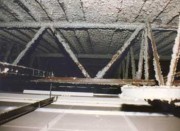
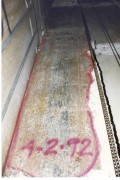
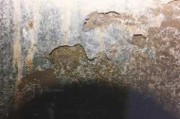
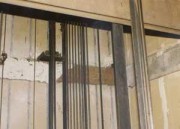

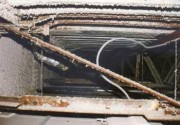
BY ROGER G. MORSE
I investigated the fireproofing in both World Trade Center towers over approximately a 10-year period between the early 1990s and early June 2000, the last time I was in the towers.
There were problems with the fireproofing in the World Trade Towers that may have rendered them vulnerable to fire. These problems are not unique to the WTC; I have observed similar problems with the fireproofing in many high-rise buildings in the United States and Europe.
FIREPROOFING TYPES
(Editor's note: "Fireproofing" is the name commonly given to fire-resistive coatings applied to structural steel components of high-rise buildings to protect them from the heat of a fire. Fireproofing is a critical fire safety feature of steel high-rise structures because steel begins to elongate between approximately 800°F and 1,000°F, temperatures easily reached by normal residential and commercial contents fires. Building codes require its utilization as well as its proper application. Fire codes require its constant maintenance.
Four different fireproofing materials were used during the construction of the World Trade Towers.
The initial material used for most of the fireproofing (later withdrawn because it contained asbestos) was a mineral fiber formulation consisting of about 20 percent chrysotile asbestos, 60 to 65 percent mineral wool, and the remainder made of gypsum and Portland cement binder. This was sprayed on structural steel up to the 36th floor and parts of the 37th and 38th floors of the North Tower.
Above this point in the North Tower, and for the entire structure of the South Tower, the spray was an asbestos-free successor to the original product consisting of mineral wool and binder. These formulations were applied to core columns, the outside face of the exterior walls and columns, the long-span steel joists (trusses) that supported the concrete floors, and trench headers for the underfloor raceway system.
Click here to enlarge image
The third type of spray, a lightweight gypsum plaster with vermiculite aggregate, was used on the inside face of the exterior walls and columns and on the seats supporting the long-span joists. This material contained no asbestos.
The fourth formulation was a "hard coat" consisting of 80-percent chrysotile asbestos set in a matrix of Portland cement. This was sprayed over the mineral fiber fireproofing in locations where it was thought that the more friable fireproofing material could suffer from vibration or air erosion. As such, this "hard coat" was used in the high-speed elevator shafts between the concourse level and the 44th- and 78th-floor sky lobbies in both towers, where it was thought that air currents from the "piston effect" of the elevators could damage the fireproofing. This material was also applied to the ceilings of the four mechanical equipment floors (in both towers) and on the ceilings immediately below these floors.
Click here to enlarge image
The WTC towers were built at the time of transition from asbestos-containing fireproofing to nonasbestos formulations. The nonasbestos fireproofing protecting some of the floors, including the floors impacted by the airplanes, was in some ways inferior to asbestos-containing fireproofing. The nonasbestos materials are less dense, less uniform, and less cohesive to the surface. Nonasbestos fireproofing materials were rushed into use, in some instances without the benefit of full-scale fire tests. To make matters worse, there were no field tests to determine if fireproofing materials were properly installed until 1977, when the American Society for Testing and Materials (ASTM) published tests for adhesion, cohesion, thickness, and density of applied fireproofing. If these tests had existed in the early 1970s, when the towers were built, then the deficiencies outlined below could have been discovered and corrected.
APPLICATION DEFICIENCIES
Fireproofing was applied directly to the long joists that supported each of the floors. Inspections of the floors with asbestos-containing fireproofing (up to the 38th floor in the North Tower) found that there were numerous areas where the fireproofing had never been applied. Top and bottom chords and truss web members were exposed, and the red lead on the trusses was clearly visible in many locations. Photo 1 shows a truss with fireproofing missing from its end where it meets the outside wall. Also, the fireproofing was frequently thinner than the 3/4 inch described in the Federal Emergency Management Agency-funded ASCE BPAT report on the collapse of the towers. Many of the problems observed were clearly the result of poor workmanship.
However, the nature of the structures that were fireproofed and application methods used could also contribute to the problem. Applying fireproofing to a long-span or any type of joist construction is difficult. The round rods and small angles making up a truss are difficult targets for the installer. Spray fireproofing materials are typically applied from the floor with an extended spray nozzle. The installer may be unable to reach or see certain areas of the trusses that must be covered. This frequently results in thin or absent fireproofing on surfaces hidden from the floor by the bottom of steel members (photo 2). In the WTC, this resulted in sections of the top surface of the bottom chord of the trusses receiving an inadequate coat of fireproofing. These are deficiencies that would have been easily discovered by the ASTM field quality assurance tests for adhesion, cohesion, thickness, and density had these test methods existed at the time of construction.
Click here to enlarge image
I inspected core columns up to the 78th floor but was unable to access them above that point. These inspections revealed that the bond of fireproofing on core columns had failed in many locations and the fireproofing was falling off the columns in floor-high sheets. Photo 3, taken in 1994, shows a core column from which the fireproofing had fallen off in a sheet that is several stories high. The red circle and date was the Port Authority's response to the missing fireproofing. This resulted because the steel had not been properly prepared at the time of the initial spray application. Rust scale had not been removed prior to applying the fireproofing. The fireproofing had adhered well to the rust scale, but the rust was coming loose from the steel (photo 4).
Click here to enlarge image
Examining the rust, I discovered that cement paste from the fireproofing had run behind flakes of the rust, indicating that the rust existed at the time the fireproofing was applied. The result was that the fireproofing adhered loosely to the columns and would fall off in large sheets. This defect was never corrected and still existed in June 2000 and probably at the time of the plane crashes. It is possible the fireproofing was missing from sections of columns on the impact floors or that some or all of the loosely adhered fireproofing fell off with the force of the impacts. This is a defect that would have been easily discovered by the ASTM adhesion and cohesion quality assurance test, had this standard existed at the time of construction.
Click here to enlarge image
In addition, there were a number of areas in the elevator shafts where fireproofing on core beams had been knocked off by elevator cables or had been damaged by foot traffic during installation of the elevator equipment (photo 5).
Fireproofing on joist-to-wall connections was also deficient. The long-span joists were supported by an angle seat welded to the face of the exterior columns. The fireproofing applied in some places was so thin that the angle seat, the shape of the bolts connecting the joist to the seat, and the bolts holding together the spandrel panels could be readily discerned. According to building drawings, these areas should have had a fire rating of four hours. For such a rating, properly applied fireproofing should be at least one to 11/2 inches thick. At this thickness, the bolts and even the angle seat itself would not be discernable (photo 6).
Click here to enlarge image
There were a number of locations in the WTC towers where the work of other trades obstructed the installation of the fireproofing. This is a common problem in high-rise construction in which ductwork, conduits, and piping are installed before the fireproofing. Building codes should be strengthened, requiring that fireproofing be installed prior to the work of other trades. This is the only way that a continuous and uniform layer of fireproofing can be applied.
LACK OF QUALITY ASSURANCE TESTING
The WTC was built before there were accepted standards for determining if the fireproofing as applied in the field would perform properly. Would the material remain on the steel (adhesion), resist physical damage (cohesion), insulate properly (thickness and density), and behave as a fire retardant? Architects relied on the "testing" undertaken by Underwriters Laboratories. However, without field quality assurance tests, there was no way of knowing if the properties of the applied fireproofing matched those of the material subjected to the UL test. The previously discussed tests would not become available until years after the completion of the WTC. For example, the ASTM test for adhesion would have detected the bonding defects of the fireproofing on core columns. This test and the ASTM test for thickness and density would have determined the adequacy of the spray fireproofing on the floor joists.
The WTC should not be considered unique in this regard. The fireproofing in any building constructed before the ASTM standards became available in 1977 should be considered suspect.
ACCUMULATED DAMAGE TO FIREPROOFING
There is another important aspect to this issue. There is no existing requirement in any building or occupancy code to inspect the fireproofing in a building periodically to determine if it has degraded through gradual physical damage. This is even true for new construction where the fireproofing is installed and tested early in the construction process. Successive work by many trades often damages and removes whole sections of fireproofing. In the WTC, the fireproofing coatings had been damaged by later construction and renovation in many locations.
LESSONS LEARNED
In considering the possible causes of the collapse of the WTC towers, the possibility that the initial application of fire-resistive coatings was deficient must be considered. The implications of this are far ranging. The fire safety of buildings depends on the fire-resistance ratings' successfully resulting in buildings that stay standing despite fire damage. Prior to the collapse of the WTC towers, it was thought that adherence to the fire-resistance ratings in the building codes would result in buildings that were safe for occupants and for those who fight fires. However, the entire scheme currently used to make these determinations must be called into question. If the WTC towers were properly protected but fell anyway, then this would indicate that the fire-resistance ratings and structural reliability of buildings as they are now built are insufficiently protective. However, if the buildings failed because the fireproofing was improperly applied, then the standards for fireproofing application and maintenance need to be strengthened. Peoples' lives depend on properly analyzing these issues and then taking appropriate corrective action.
Deficient firestopping
Deficient firestopping provides an avenue for fire spread. Columns, girders and beams are commonly protected with spray asbestos insulation or a composition material. Spray insulation has been tested to offer four-hour test ratings on columns, three hours on beams and girders.
Test conditions, however, do not match actual conditions in the field. Insulation adhesion may be ineffective because of rust. Frequently, insulation is applied to rusted metal that has not been properly treated before application; the insulation's consistency may vary; its application may be inconsistent; or it may be dislodged during original and new construction and maintenance.
Source: HighRise/Fire & Life Safety, by John T. O'Hagan, Fire Engineering, 1977, pp. 23-28
Photos by author.
ROGER G. MORSE is a member of the American Institute of Architects and director of Morse Associates, which focuses on forensic building investigation.



